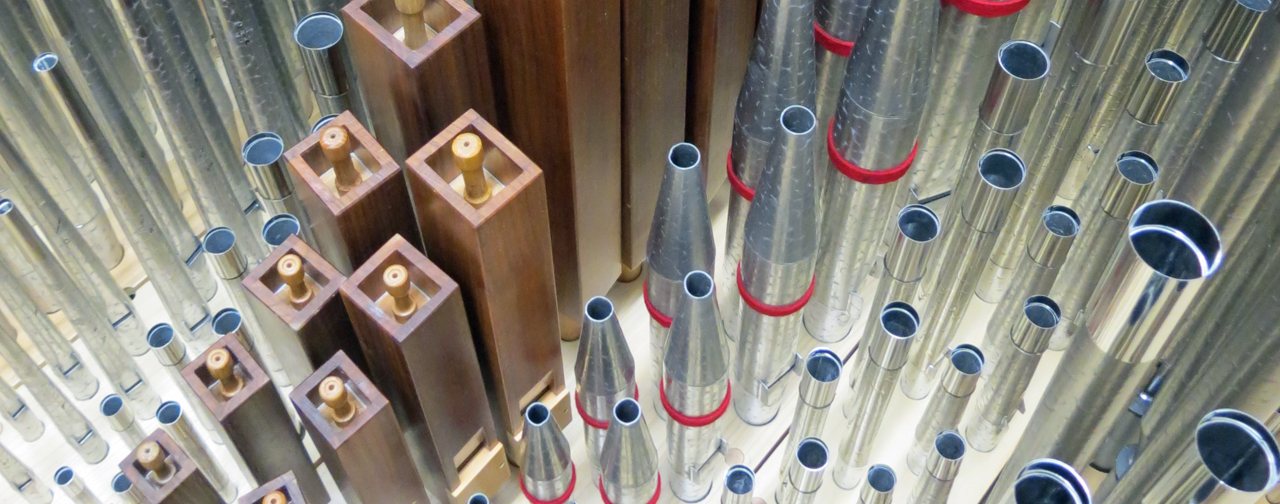The PJM Sound
Patrick J. Murphy organs all have an enviable list of characteristics in common: cohesiveness, color, integrity, heritage, reliability, flexibility, warmth, power and value. Yet just as brothers and sisters are unique individuals developing from the same genetic material, each PJM instrument is unique without losing the strong family resemblance. The order of priority of each characteristic varies, as does its relative weight in the overall scheme. But in every case, the finished result is an artistic and pragmatic response to a very specific set of challenges and goals.
Let us examine each of those characteristics and how they are exhibited in a PJM instrument.
Cohesiveness. The very core of any PJM instrument is the strength of its Principal choruses. The component stops are scaled in such a way that each successive pitch locks into the one before. Whenever possible, these stops are planted on slider chests to further encourage the blend. The result is a plenum that is neither timid nor harsh, but clear and compelling.
Color. Difficult to define, but its presence or absence is immediately apparent. Color is what makes one stop stand out from another in a solo role, or makes it blend with a complimentary color to produce a third. Absence of color makes an organ dull or oppressive. Variety of color is the gracious byproduct of function-driven tonal design. The pursuit of variety for its own sake almost always compromises functional integrity.
Integrity. PJM organs have an overall integrity of design as well as execution. Tonal schemes are carefully designed to meet the musical requirements. Physical layout and engineering are planned with an eye for ease of tuning and maintenance. Seldom seen parts of the instrument are built with the same attention to detail as those much more visible.
Heritage. Organbuilders for generations have learned their art from those who have come before. From the earliest times to the present, new organs have incorporated not only the wisdom and methods of the past but frequently also pipes and mechanisms. In addition to the firm’s commitment to sensitive restoration of existing instruments, Patrick Murphy’s long-time association with the Organ Historical Society encourages his desire to retain high quality existing pipework in new instruments when the result is musically viable.
Reliability. PJM maintains an extensive list of tuning and service clients, giving us the opportunity to observe first-hand the benefits and liabilities of many different types of organ design. We incorporate into our own work the ideas we find consistently working well, and look for ways to avoid repeating the things that are constant trouble spots.
Flexibility. Designed by organists for organists, PJM understands the wide variety of demands made of an organist in the 21st century. We make every effort to provide the flexibility necessary to ease the organist’s job without compromising the integrity that defines the pipe organ.
Warmth. While some might think of warmth only in terms of a string and celeste, we see it in a much larger context in the way stops blend together. Just one example might be the “French Quartet” or “Fonds d’huit”, where several different unison stops each have a distinct role in creating a complex composite sound. The Diapason provides the basic color; the Bourdon contributes weight and breadth; the Flute Harmonique adds intensity and carrying power; the Gamba defines the edges of the sound and focuses it. The resulting texture is rich and warm, a sound that cannot be had any other way.
Power. Although a PJM organ is fully capable of filling a room with sound, power is not dependent on numbers of decibels alone. The true power of an organ lies in its ability to stir the heart to heights of celebration and depths of meditation, to excite and soothe the human spirit.
Value. Value is the ratio of benefit gained in comparison to cost paid. The wise purchaser must always look beyond simple numbers of pipes or amount of equipment. The value is in how those components work together to produce an intangible and not easily quantifiable musical result. The value is in the personal relationship with the organbuilder and his crew which will probably last years beyond the dedication day. The value is in making a major investment in something real, something beautiful and custom-built. The value is in looking the next generation squarely in the eye and being able to say “When we had the opportunity, we chose to provide for you the very best!”

